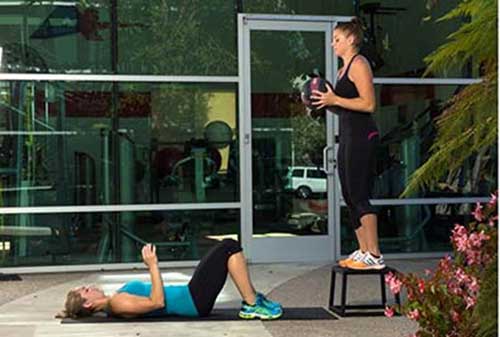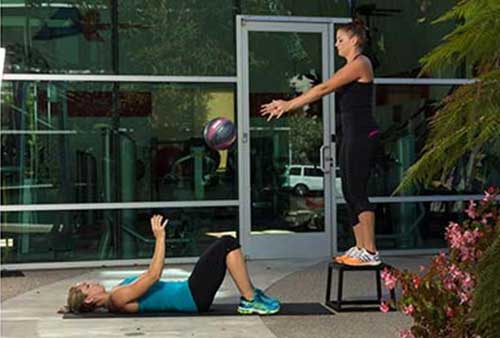Plyometrics are quick, explosive types of movement that can help you burn large amounts of calories in minimal time while also strengthening your muscles.
As a form of body-weight exercise that requires no equipment (other than your own body), plyometric movements have been around virtually forever, although they didn’t start out as “exercise.”
The explosive movements involved in plyometrics, such as vertical jumps, were certainly invaluable to the survival of ancient humans. And such movements were later coveted by athletes at the first Olympics.
As the American Council on Exercise (ACE) put it, plyometric exercise has been in use “since the first Olympians in Greece donned white robes and grape leaf crowns.”1 Later, plyometrics were valued by Eastern European Olympians during the 1970s, who used the moves to build strength and power.2
What Makes Plyometrics Such a Good Workout?
When done properly, plyometric exercises have been shown to improve leg strength, muscle power, acceleration, balance, agility, and vertical jumps.3There’s also evidence that they may help build bone density, particularly in younger adults, while also helping with weight control and lower the risk of sports-related injuries.4
While once thought of as an exercise strictly for adults, plyometrics can be safely performed by adolescents and children, too. As the American College of Sports Medicine noted, “plyometrics are a natural part of most movements, as evidenced by the jumping, hopping, and skipping seen on any school playground.”5
Many of the benefits of plyometrics come from the muscles’ cycle of lengthening and shortening, which increases muscle power.6 ACE explained:7
“The premise behind using plyometric exercise to improve reactivity and power output comes from what’s called the ‘stretch shortening cycle.’ This term refers to the change a muscle goes through when being eccentrically loaded and then concentrically contracted.
What is actually being trained while doing plyometics is the very short period in between the eccentric (lengthening) and concentric (shortening) phases of this muscle contraction.
This is called the ‘amortization phase’ and it is a very quick moment in time when the muscle goes from being eccentrically contracted, or stretched while under load, to concentrically contracted, which is what we normally think of as flexing a muscle.
When plyometrics are done quickly, as intended, the amortization phase should last less than one-quarter of a second… The shorter the amortization phase, the quicker a muscle goes from a long muscle to short muscle, which allows for increased force production.”
Four Simple Plyometric Moves
Many familiar exercises can become plyometric movements if you add an explosive burst. To do a plyometric push-up, for instance, once your sternum touches the floor hold your position and breathe for about three seconds, then perform an explosive push upward. You can also try jump squats or jumping on and off a small box.
If you’re looking for something different to try, fitness and nutrition coach Adam Rosante, author of The 30-Second Body, shared four simple plyometric moves with Yahoo Health.8 These are appropriate for most fitness levels.
1. Pile Jumps
“…standing with your feet wider than shoulder-width apart, toes turned out wide, and arms lifted in front of you. Press your knees out over your toes, then explode straight up and land softly.”
2. Squat Push-Ups
“…come into a squat position, drop your hands to the floor, shoot your feet back, and complete one push-up. Hop your feet forward, lift your chest, and repeat.”
3. Deep Mountain-Climbers
“…start at the top of a push-up position and step your right foot to the outside of your right hand. Keeping your core tight, explosively switch feet.”
4. Table Saws
“…starting on your butt with your hands and feet flat on the floor. Press hips up and kick up your left foot as you swing your right hand up and over. Alternate sides.”
Plyometrics for Your Upper Body and Trunk
Plyometrics are often thought of as a lower-body workout, but they can be used for your upper body, and even your trunk, too. Jacque Crockford, MS, CSCS, an ACE certified personal trainer and an ACE exercise physiologist, shared the following plyometric exercises:9
Supine Vertical Chest Toss (Upper Body)
”Lie supine on a mat with your arms extended upward (shoulders at approximately 90 degrees of flexion). Have a partner stand on top of a box and hold a 2- to 8-lb (1- to 3.5-kg) medicine ball above the exerciser’s arms. When the partner drops the ball, catch the ball using both arms and immediately toss the ball back up to the partner.”
Lateral Med Ball Wall Throw and Catch (Trunk)
“Grasp a medicine ball and stand sideways about 2 to 3 feet away from a wall. Using the hip as a starting point, rotate the body and throw the ball toward the wall, catching it back at the hip while returning to the starting position.”
More Is Not Better with Plyometrics – Be Careful to Avoid Injury
Because plyometric exercises are so intense, you should only do two to three sessions a week to give your body time for adequate rest and recovery. And as you exercise, pay attention to proper form and quality of movement over quantity. Certain plyometric movements, such as depth jumping and drop jumping, can exert a force of up to seven times your own bodyweight.
In short, plyometrics can be dangerous if not correctly, and they may even pose a higher risk of injury than other forms of exercise. For instance, it’s not unusual for ankle or other injuries to occur during plyometric jumps. As ACE reported:10
“If you are considering plyometrics, proceed with caution. A sports medicine physician or therapist can advise you on whether this training technique is suitable for you, and may even help you get started or recommend someone who can. But, if improving athletic performance is not a high priority, the additional risk associated with this activity may not be worth the potential benefits.”
So it’s important to start out gradually and, ideally, under the supervision of a personal trainer, at least for your first few sessions. Listen to your body and do the exercises you feel comfortable with – avoid pushing yourself too much at the start of a plyometrics workout, as it takes time to build coordination and strength. You can lower your risk of injury when performing plyometrics by following some simple ground rules from ACE:11
- Only do jumps from ground level, ideally onto soft grass or a padded gym mat
- Use safe-landing techniques, such as from toe to heel when doing vertical jumps
- Landing on your entire foot (as a rocker) helps dissipate landing forces over a greater surface area
- Picture yourself landing “light as a feather” and “recoiling like a spring” after impact to help reduce the landing forces
- Avoid excessive side-to-side motion of the your knees when landing; according to ACE, “Landing forces can be absorbed through the muscles that help support and protect the knee joint (quadriceps, hamstrings, and gastrocnemius) more effectively when the knee is bending primarily in only one plane of motion.”
Plyometrics Won’t Produce Human Growth Hormone (HGH)
One reason why exercise is sometimes regarded as a real-life fountain of youth is because, when done intensely, it boosts your body's natural production of human growth hormone (HGH), a synergistic, foundational biochemical that addresses the serious muscle loss and atrophy that typically occurs with aging. However, not all types of exercise boost its production. Your body has three different types of muscle fibers:
- Slow (red, oxygen-rich muscle)
- Fast (also red muscle that oxygenates quickly, but is five times faster than the slow fibers)
- Super-fast (white muscle fibers that contain far less blood and mitochondria)
The super-fast muscle fibers are the only muscle fibers that have any major impact on your production of HGH. Unfortunately, the vast majority of people, including many athletes such as marathon runners, only train using their slow muscle fibers, which can actually cause the super-fast fibers to decrease or atrophy.
It's important to understand that neither traditionally performed aerobic cardio nor conventional strength training will workanything but your slow muscles. Power training with plyometrics will engage your fast muscle fibers, but still will not affect HGH production to any great degree.
Generally, the higher your levels of HGH, the healthier and stronger you will be. So in addition to plyometrics, be sure you are also engaging in high-intensity interval training. This is especially important once you hit the age of 30, which is when you enter what's called "somatopause.”
At this point your levels of HGH begin to drop off quite dramatically. This decline of HGH is part of what drives your aging process, so maintaining your HGH levels gets increasingly important with age. Whether you seek to optimize your athletic performance or health and longevity, incorporating one to three sessions of high-intensity exercises per week will help you achieve your aims by significantly boosting HGH production. In addition to Peak Fitness, super slow weight training is another form of high-intensity exercise that will significantly boost your HGH production.


No comments:
Post a Comment